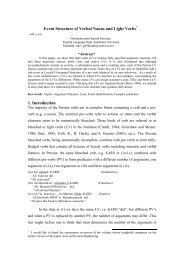Separability of Light Verb Constructions in Persian*
Separability of Light Verb Constructions in Persian*
Separability of Light Verb Constructions in Persian*
You also want an ePaper? Increase the reach of your titles
YUMPU automatically turns print PDFs into web optimized ePapers that Google loves.
they cannot be relativized and focused on by Wh-<strong>in</strong>terrogatives. Therefore, they fall<br />
under the category <strong>of</strong> <strong>in</strong>separable LVCs (Karimi-Doostan, 1997). In contrast, the LVCs<br />
with nom<strong>in</strong>al PVs (5d) behave differently. Some <strong>of</strong> them can appear <strong>in</strong> sentences such as<br />
those <strong>in</strong> (3) while some cannot and they resist separation <strong>in</strong> the syntax as <strong>in</strong> (4) and (5).<br />
Thus, the LVCs <strong>of</strong> (6d) type fall <strong>in</strong>to two groups: separable and <strong>in</strong>separable LVCs.<br />
3. The Components <strong>of</strong> <strong>Light</strong> <strong>Verb</strong> <strong>Constructions</strong><br />
We believe that, to expla<strong>in</strong> the separbility and <strong>in</strong>separability <strong>of</strong> LVCs (3-5), it is<br />
necessary to uncover the semantic and morphosyntactic characteristics <strong>of</strong> members <strong>of</strong><br />
LVCs. As mentioned earlier, every LVC <strong>of</strong> (6d) type, separable or <strong>in</strong>separable, consists<br />
<strong>of</strong> a LV and a nom<strong>in</strong>al PV. We will exam<strong>in</strong>e and elaborate on the properties <strong>of</strong> LVs <strong>in</strong><br />
(3.1) and the semantic and morphosyntactic features <strong>of</strong> nom<strong>in</strong>al PVs will be presented<br />
and focused on <strong>in</strong> (3.2).<br />
3.1. <strong>Light</strong> <strong>Verb</strong>s 2<br />
In Megerdoomian (2002: 77) LVs are <strong>of</strong> two k<strong>in</strong>ds: Inner LVs and Outer LVs.<br />
The former contributes the <strong>in</strong>ner event, <strong>in</strong>ternal argument and aspect but the latter<br />
contribute the outer event, external argument and aspect. Folly, Harley and Karimi (2005:<br />
1379) believe that LVs play agent/cause, eventive and duration roles <strong>in</strong> LVCs. Karimi-<br />
Doostan (1997: 99-131), study<strong>in</strong>g a wide range <strong>of</strong> LVs <strong>in</strong> Persian <strong>in</strong> detail, concludes that<br />
LVs, lack<strong>in</strong>g thematic roles and fully specified a-structure, have preserved their lexical<br />
aspectual properties and they determ<strong>in</strong>e the (a)telicity <strong>of</strong> the VPs. Karimi-Doostan (2005:<br />
1743-4), claim<strong>in</strong>g that LVs are accusative case markers, po<strong>in</strong>ts out that it is unknown<br />
whether <strong>in</strong> LVCs (a)telicity follows from case properties or vice versa. To understand the<br />
nature and morphosyntactic and semantic characteristics <strong>of</strong> LVs <strong>in</strong> Persian we compare<br />
them with heavy (lexical) verbs and auxiliaries <strong>of</strong> this language <strong>in</strong> sections {3.1.1} and<br />
{3.1.2}.<br />
2 . The relationship between light verbs <strong>in</strong> Persian and little v <strong>in</strong> M<strong>in</strong>imalist Programme (Chomsky, 1995;<br />
1999; 2001; Radford, 2004; among others) is dealt with <strong>in</strong> Karimi-Doostan (2005).<br />
8



